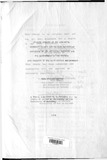| dc.description.abstract | The extraordinary career of Ahmadiyyat in East Africa raises the pregnant question of its significance within the religious milieu as a whole* Behind the facade of a vigourous propagandism there is a movement that is geographically
extensive and yet numerically inconsiderable. Because its influence seems to be out of proportion to its numerical strength the task of the researcher is to discern its authentic consequence within the general context of East African Islam. In order to perceive the dimensions of its impact every aspect of the Ahmadiyya presence in this part of Africa requires careful scrutiny.
This study commences predictably with a delineation of the origins of the movement on the Indian sub-continent*
It proceeds to show how Ahmadiyyat in East Africa fits into the broader mosaic of its global outreach. Its beginnings are traced to some of the early Ahmadis who migrated from India to the British and German territories at the turn of this century. These were the harbingers of a missionary undertaking that was eventually established. The expansion of the missionary endeavor and the development of its propagation are then portrayed. A necessary excursion is made into the question of how Ahmadis are regarded juridically
as pertains their religious status.
The discussion proceeds with a description of the Ahmadiyya contribution in the realm of apologetic and polemical literature. Herein is seen an important clue to its
vii
influence. A steady stream of Swahili publications produced by the missions has enjoyed a wide-ranging reader- ship. The translation and publication of Kurani Tukufu, a Swahili translation of the Quran, has been a singular achievement of considerable import,. It is through this and other publications of varying description that Ahmadiyyat has manifest its distinctive form of Islam to Africans,,
The printed word is the significant medium for the advocating
of Ahmadiyya doctrine and practice among literate Africauso
Active propagation through publications coupled with the extensive itineration of missionaries has brought Ahmadis into direct confrontation with both Christians and Muslims. The anti-Christian posture seems mainly to be aimed at enhancing the Ahmadiyya image with non-Ahmadiyya Muslimso Christians have by and large chosen to ignore the Ahmadiyya antagonisms. Some discernible reasons for such passivity are suggested. Muslims, on the other hand, representing both Sunnis and Shias have staunchly contended against the Ahmadiyya polemics. The end result of such active controversies has been unproductive as far as proselytism is concerned. Nevertheless, their relentless propagandist! has made Ahmadiyyat an undeniable stimulus among Muslims. Its influence on the Islamic community is discerned as an encouragement to propagation and polemics from quarters that would otherwise not likely be so disposed.
The thesis concludes by showing how Ahmadiyyat has caused Muslims to seek a revitalised role in the religious scenario of East Africa | en_US |

